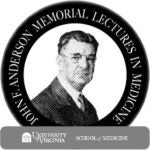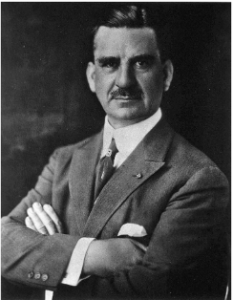Anderson Lecture and Symposia
About
 The John F. Anderson Memorial Lectureship was established in 1955 by Dr. John F. Anderson, a graduate in 1895 of the University of Virginia, School of Medicine. Through his gift to the University, it has been possible to establish a lectureship in medical science and public health which will bring to this medical community the latest developments in these fields.
The John F. Anderson Memorial Lectureship was established in 1955 by Dr. John F. Anderson, a graduate in 1895 of the University of Virginia, School of Medicine. Through his gift to the University, it has been possible to establish a lectureship in medical science and public health which will bring to this medical community the latest developments in these fields.
Dr. Anderson made many outstanding contributions to the science of medicine during his long career of service and leadership in public health, medical research, and medical production. Dr. Anderson was the third director of the Hygienic Laboratory (the predecessor of the NIH) and was among the early scientists who made the Laboratory well-known in scientific circles.
History: With cholera importation a looming threat to America, Dr Joseph Kinyoun entered the Marine-Hospital Service (MHS) on 4 October 1886 in a key position at the Staten Island quarantine station, the most likely port of entry for exportable European infectious diseases like cholera. As was customary in the MHS, and probably as a legacy of the secretive former military man/MHS Surgeon General Woodworth, Kinyoun received a code name he carried with him throughout his MHS career: Abutment. The New York quarantine station hospital (still standing as of 2012) was a facility newly rented from the Marine Society, the entire station having just been relocated from Bedlow (Bedloe) Island (now called Liberty Island) to allow construction there of the Statue of Liberty. The nation’s first federal bacteriology laboratory was established in a museum room and Kinyoun was placed in charge of it on August 27, 1887, a date that serves as the beginning of the NIH. The Hygienic Laboratory began as a diagnostic laboratory supporting MHS quarantine activities against the (then) four quarantinable epidemic diseases: cholera, yellow fever, smallpox, and plague. Kinyoun was succeeded as director of the Hygienic Laboratory by Dr. Milton Rosenau, a pioneer in the study of anaphylaxis, with research on yellow fever, malaria, typhoid, polio, and pasteurization of milk). On September 30, 1909, Rosenau resigned from government service to join the staff of Harvard Medical School and, in 1936, he moved to the University of North Carolina as Director of the Public Health School.

John F Anderson
John F Anderson, who received his M.D. degree at the University of Virginia, returned in 1898 from studying bacteriology in Europe. He joined the Marine Hospital Service and on October 1, 1909, succeeded Dr. Rosenau as Director of the Hygienic Laboratory. Anderson studied serum and vaccine therapy, immunology, cholera, typhus, polio, as well as public health and sanitation problems. He worked with Dr. Rosenau on hyper-susceptibility, anaphylaxis, and tuberculosis, and with Dr. Joseph Goldberger on the transmission of measles to monkeys, providing science with an experimental animal for that disease. Dr. Anderson served as Director of the Hygienic Laboratory until November 19, 1915, when he resigned to become Director of the Research and Biological Laboratories, and later Vice President, of E. R. Squibb & Sons. He died in North Brunswick, New Jersey, on September 29, 1958, at the age of 87.
Anderson Lecture Nomination Form
For questions, please contact Joyce Fortune, JCF9U@uvahealth.org
Anderson Symposium Form
September 12, 2023 Jennifer Doudna, PhD, University of California, Berkeley, and HHMI (Anja Bielinsky, Host)
October 24, 2022 Taekjip Ha, PhD, Johns Hopkins University and HHMI (Lukas Tamm, Host)
April 18, 2022 Aviv Regev, PhD, Genentech/Roche and the Broad Institute of MIT/Harvard (Mark Okusa, Host) (virtual)
October 27, 2021 Phillip D Zamore, PhD, University of Massachusetts Medical School and HHMI (Jogender Tushir-Singh, Host) (virtual)
March 22, 2021 Richard Henderson, PhD, MRC Laboratory of Molecular Biology (Cambridge, UK) (Ed Egelman, Host) (virtual)
February 5, 2019 Helen H Hobbs, MD, UT Southwestern Medical Center and HHMI (Gary Owens, Host)
October 8, 2018 Fred H (Rusty) Gage, PhD, Salk Institute for Biological Studies (Mike McConnell, Host)
June 2016 Craig C Mello, PhD, University of Massachusetts Medical School and HHMI (Todd Stukenberg, Host)
March 7, 2017 Robert Langer, ScD, Massachusetts Institute of Technology (George Christ, Host)
October 5, 2015 Mary-Claire King, PhD, University of Washington (Stephen Rich, Host)
June 15, 2015 Lew Catley, PhD, Weill Cornell Medical College (Todd Stukenberg, Host)
March 24, 2015 Eric Betzig, PhD, University of California, Berkeley, and HHMI (Janelia Farm Research Campus) (Jay Fox, Host)
September 25, 2013 April Greenan, PhD, University of Mary Washington
November 17, 2010 Catherine Belling, PhD, Northwestern University
November 10, 2010 Abigail D Zuger, MD, St Luke’s-Roosevelt Medical Center and Columbia University College of Physicians and Surgeons, and medical writer, The New York Times
October 20, 2010 Jane Macnaughton, MD, PhD, Durham University (UK)
There were numerous Anderson Memorial Lecture as co-presentations (and others as part of the Medical Center Hour) in the 2010-2015 period.
